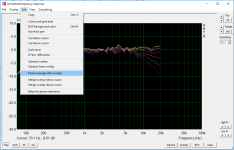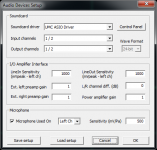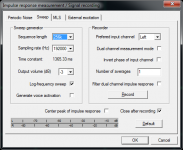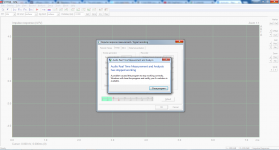Thank you for the quick and well-founded answer....allowing me to save some money
Well, so I have to search for something different as measurement microphone...
Btw, I have a MCE-2000 capsule in my junk box (I believe it is equivalent to Panasonic WM-60) and a suitable preamp/phantom power circuit, but have no idea how to calibrate...
My experience is that the "calibration" you get with such "cheap" microphones is not great. I have a "cheap" Beyerdynamic measurement microphone that came with specific calibration data. When I compared this to other more expensive microphones I found that the Beyerdynamic calibration data was not good, so I sent it to an external lab for proper calibration (not as cheap as you'd like it to be). I could have had this much easier by paying slightly more for a properly calibrated microphone.
That said, I guess that most applications do not need a calibrated microphone to get you there. The variations you see during developing or repairing a speaker are usually much larger than the difference between the calibrated vs. uncalibrated microphone (except maybe at the exteme ends of the spectrum). I would recommend you to go ahead with your existing Panasonic capsule (mine was surprisingly flat before I broke it). If you think you need something better for your speaker projects, you can uprade later.
Simon, good approach! Any suggestions as to the step down transformer?
See my post earlier in this thread:
http://www.diyaudio.com/forums/multi-way/76977-arta-12.html#post5191790
The input input side of the transformer (going to the crossover/speaker) has a 1.3k impedance and the output side (going to the sound card line level input) an impedance of 30 ohms, so a 43 to 1 impedance ratio.
As I use the balanced line level input on my Behringer UMC204HD I have the shield can of the transformer connected to the ground pin on the XLR and the 30 ohm secondary pins connected to signal +/- which are floating with respect to earth. To avoid confusion, the photo was taken back when I was using an unbalanced sound card input, which is why you only see two wires.
The 1.3k input side of the transformer can be connected to balanced or unbalanced signals as it is fully floating.
Thanks for the advise. Will start with that now and upgrade later, or maybe I'll find someone who does calibration service.[....]I would recommend you to go ahead with your existing Panasonic capsule (mine was surprisingly flat before I broke it). If you think you need something better for your speaker projects, you can uprade later.
I used to do this: Dienstleistungen | HiFi-Bau Brennwald (sorry, it's in German. Google Translate may help.)Thanks for the advise. Will start with that now and upgrade later, or maybe I'll find someone who does calibration service.
German no problem, and thanks for pointing me to this. Looks good and reasonably priced. Will have to build the capsule with circuit into a mechanically sound enclosure before though.I used to do this: Dienstleistungen | HiFi-Bau Brennwald (sorry, it's in German. Google Translate may help.)
Btw, DeepL is running circles around Google wrt translation German-English....
Sorry for OT, and thanks to all helping me out with my first steps in the acoustic measurement field. All I did up to now was electrical...
See my post earlier in this thread:
http://www.diyaudio.com/forums/multi-way/76977-arta-12.html#post5191790
The input input side of the transformer (going to the crossover/speaker) has a 1.3k impedance and the output side (going to the sound card line level input) an impedance of 30 ohms, so a 43 to 1 impedance ratio.
As I use the balanced line level input on my Behringer UMC204HD I have the shield can of the transformer connected to the ground pin on the XLR and the 30 ohm secondary pins connected to signal +/- which are floating with respect to earth. To avoid confusion, the photo was taken back when I was using an unbalanced sound card input, which is why you only see two wires.
The 1.3k input side of the transformer can be connected to balanced or unbalanced signals as it is fully floating.
Thanks Simon, but this link does not seem to refer to the relevant post; I'll figure it out using the search function.
This question must have come up before, but can't find an answer:
Is there a way in ARTA to calculate the average respons from a range of measurements? For example to calculate the average response over a 30 degree section?
If not, is there some software on the market which will do that?
Is there a way in ARTA to calculate the average respons from a range of measurements? For example to calculate the average response over a 30 degree section?
If not, is there some software on the market which will do that?
averaging overlays
You cant average in ARTA, but you can export all responses in .csv format and import in excel and do calculation.
Ivo
This question must have come up before, but can't find an answer:
Is there a way in ARTA to calculate the average respons from a range of measurements? For example to calculate the average response over a 30 degree section?
If not, is there some software on the market which will do that?
You cant average in ARTA, but you can export all responses in .csv format and import in excel and do calculation.
Ivo
You cant average in ARTA, but you can export all responses in .csv format and import in excel and do calculation.
Ivo
Maybe you can export the data as a csv-file that you can post-process with a spreadsheet program.
Is there a way in ARTA to calculate the average respons from a range of measurements? For example to calculate the average response over a 30 degree section?
If you are after a power average of a group of impulse measurements, this can be done thru the Edit menu on the Smoothed frequency response window. See page 93 in the Users Manual. Open your impulse measurement, use the Single-gate smoothed frequency response, select smoothing as desired, and then save as an overlay. Repeat for each of your +30deg thru -30deg measurements. Then select the "Power average with overlays" option from the Edit menu. You can export the result as an ASCII or CSV file.
If you only have measurements for 0deg to +30deg, you can enter the +deg measurements twice(saving as 2 separate overlays) to cover the -deg space.
Attachments
This question must have come up before, but can't find an answer:
Is there a way in ARTA to calculate the average respons from a range of measurements? For example to calculate the average response over a 30 degree section?
If not, is there some software on the market which will do that?
You could do this with MATAA + Octave/Matlab.
Thanks for pointing that out. In practice this hasn’t proved to be a bothersome limitation.…averaging overlays and current curve is possible only if all responses are measured with same sampling frequency and smoothing…
When taking polar measurements most(all?) people leave the sampling frequency and smoothing settings unchanged from measurement to measurement.
That would speed things up a bit…loading up all angles at once rather than one at a time as overlays. Still, the capability is currently there and not too difficult to do; certainly quicker and easier than exporting to Excel or other program for processing.It would be really great if you could do it within ARTA, from the same menu and with the same way of loading the files as with the polars.
If you ever want or need to average a set of measurements taking into account their relative phase (rather than power averaged) ARTA can do that too. Use the “Load and Sum” option from the “File” menu of the Impulse Response Window to sum the impulses for all the measurements of interest. Then use the “Scale” option from the “Edit” menu to divide the magnitude by the number of measurements. Finally, set gating and calculate frequency response as usual.
Hi Ivo,
Long time registered owner of ARTA.
I've recently realised that ARTA 1.9.1 is crashing for me when I try to use the swept sine measurement method. As I normally use periodic noise (which works fine) I had not noticed this until today, so I have no idea how long this problem may have existed and through which versions.
I also stopping using ARTA for a few years (no chance for speaker development during that time) before coming back to it and when I started using it again it is with different hardware, both different PC and different sound card. I remember that swept sine worked for me with my original PC and sound card many years ago.
The crash occurs immediately following the sine sweep but before any results are displayed and happens every time.
I'm not sure what information you might require so for the moment here are screenshots of my audio device setup, the sine sweep configuration, and the crash itself.
The PC is a Samsung laptop running Windows 7 x64 and the sound card is a USB Behringer UMC204HD using asio drivers.
Regards,
Simon
Long time registered owner of ARTA.
I've recently realised that ARTA 1.9.1 is crashing for me when I try to use the swept sine measurement method. As I normally use periodic noise (which works fine) I had not noticed this until today, so I have no idea how long this problem may have existed and through which versions.
I also stopping using ARTA for a few years (no chance for speaker development during that time) before coming back to it and when I started using it again it is with different hardware, both different PC and different sound card. I remember that swept sine worked for me with my original PC and sound card many years ago.
The crash occurs immediately following the sine sweep but before any results are displayed and happens every time.
I'm not sure what information you might require so for the moment here are screenshots of my audio device setup, the sine sweep configuration, and the crash itself.
The PC is a Samsung laptop running Windows 7 x64 and the sound card is a USB Behringer UMC204HD using asio drivers.
Regards,
Simon
Attachments
Last edited:
Hi,
there is no difference in how ARTA record noise and swept sine.
The problem can be with a driver or with laptop.
I've not tested Behringer UMC204HD. Does it have control panel to adjust sampling rate?
Unstability of usb souncard drivers is typical with laptops:
- Try to measure at least 2 minutes or more after system boot. Sometimes drivers need several minutes to settle.
- Disable WiFi
- Assure that system is updated (to minimize background processes).
- Set the same sampling rate in ARTA and in soundcard control panel.
- Try different sample rates.
Ivo
there is no difference in how ARTA record noise and swept sine.
The problem can be with a driver or with laptop.
I've not tested Behringer UMC204HD. Does it have control panel to adjust sampling rate?
Unstability of usb souncard drivers is typical with laptops:
- Try to measure at least 2 minutes or more after system boot. Sometimes drivers need several minutes to settle.
- Disable WiFi
- Assure that system is updated (to minimize background processes).
- Set the same sampling rate in ARTA and in soundcard control panel.
- Try different sample rates.
Ivo



